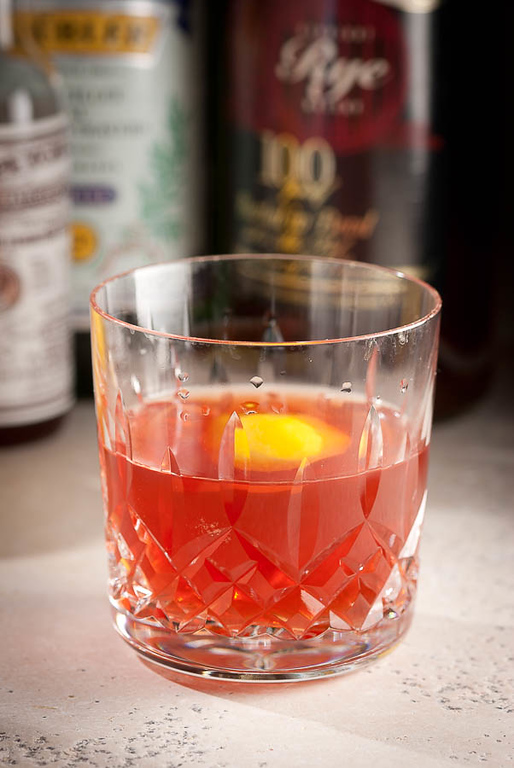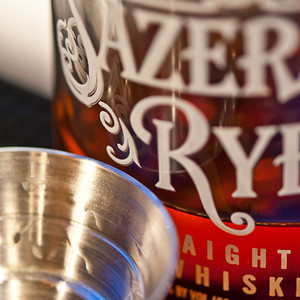The Sazerac is a love-it or hate-it kind of cocktail, with no middle ground. It’s a whiskey cocktail embellished with Peychaud’s bitters and an absinthe wash. If you’re put off by the anise and wormwood of absinthe, then the Sazarac will not be your cocktail; otherwise, keep reading—you owe yourself this New Orleans delight.
One of the oldest of cocktails, the Sazerac is also one of the most storied. In its earliest days in the New Orleans of the 1830s, it was a brandy cocktail—a “Cognac Old-Fashioned,” you might say—but specifically made with the local, newly invented Peychaud’s bitters. (I’ll come back to Peychaud and that cognac version next time.)

The Sazerac evolved into a whiskey drink when the European phylloxera epidemic of the 1870s destroyed France’s grapevines. Brandy imports dried up, so during the 1880s, good American rye whiskey came to the fore as the new standard spirit. Meanwhile, absinthe had grown in popularity as a cocktail embellishment, and it seems to be about this same time that it appeared in the Sazerac, adding a fashionable New Orleans flourish and a remarkable complexity to what was otherwise just a regional take on the Whiskey Old-Fashioned.
The recipe didn’t appear in print until William Boothby’s The World’s Drinks and How to Mix Them (1908), but that 1880s model has remained unchanged to the present.
The Sazerac Cocktail
- 2 oz Rye Whiskey (Wild Turkey 101, Rittenhouse 100, Sazerac)
- ¼ oz simple syrup (¼ oz Demerara syrup)
- 4 dashes Peychaud’s Bitters (Peychaud’s, Bitter Truth Creole)
- 1 dash Angostura Bitters (Angostura, Bitter Truth Aromatic)
- splash of Absinthe for wash (Kubler, Herbsaint)
- lemon peel garnish (optional)
Chill a rocks glass with crushed ice. In a mixing glass, combine whiskey, syrup and bitters; stir with ice until well chilled. Empty the rocks glass of ice, add a splash of absinthe, and roll the glass to coat, or “wash,” the inner surface; pour off any excess absinthe. Strain the chilled whiskey mixture into the rocks glass.
Express the lemon peel over the mixture and rub on the rim of the glass. (Optionally, add the lemon into the drink.)
The Sazerac is traditionally served without ice. I often add one cube anyway.
I used Demerara syrup in this recipe, but regular simple syrup, or even a teaspoon of hard sugar, works just fine. (In fact, I finally got around to making gomme syrup for the first time; the experiment worked out nicely, and the Sazerac seemed an obvious opportunity to try it out. I found it strange that the “silky texture” effect often attributed to gomme syrup wasn’t really in evidence; on the other hand, the drink did seem a bit sweeter than one made with regular simple syrup, and the flavors were more smoothly blended.)
 Rye whiskies definitely make superior Sazeracs, but if rye isn’t available, bourbon with a high rye content is a nice approach. I can vouch for Bulleit, Basil Hayden and Four Roses Single Barrel bourbons in the Sazerac. (Don’t tell anyone you did this.)
Rye whiskies definitely make superior Sazeracs, but if rye isn’t available, bourbon with a high rye content is a nice approach. I can vouch for Bulleit, Basil Hayden and Four Roses Single Barrel bourbons in the Sazerac. (Don’t tell anyone you did this.)
Proper absinthe is still in a spiral of trendiness, overhyped and overpriced since its recent return to the marketplace. If it’s unavailable in your area, or if you just don’t want to pay the Fashion Tax, try Herbsaint, which is one of the oldest and most respected of the absinthe substitutes. Lacking Herbsaint, try the ubiquitous Pernod. (Don’t get me wrong—real absinthe is a superior product to the alternatives; choose it if your budget allows. Hey, there are dozens of Sazeracs in that bottle…)
Which brings us to the final sticking point: The only substitute I’ve found for Peychaud’s Bitters is Bitter Truth’s Creole Bitters. Unfortunately, if your stores don’t have Peychaud’s, I’d guess they don’t have the BT Creole, either. Don’t try making a Sazerac without one of these bitters in hand. It won’t work, and the cocktail you make will not be anything like a Sazerac. Have patience, and wait for better times.
So that is the classic Sazerac. But it isn’t the “only” Sazerac. The original cognac version is absolutely delicious, and I’ll look at it more closely next time, when we ask, “Why is there cognac in my Sazerac?“
“The Sazerac Cocktail” at cold-glass.com : Text © 2012 Douglas M. Ford. Photos Copyright © 2010–2012 Douglas M. Ford. All rights reserved.

Great post, Sazeracs are one my favorites. I’ll have to give one a try using Demerara syrup, seems like that would add a little richness.
Thanks. And, yes, it’s a great go-to winter drink at my house.
I try to make sure I keep demerara on hand. Your term “richness” pretty much sums it up.
Just returned from NOLA where I had my first Sazerac. I’d never heard of it before and being a fan of the somewhat similar Old Fashioned, I loved the Sazerac! Anxious to try to make one on my own. Fingers crossed!
I’m glad you encountered the Sazerac, and enjoyed it. What better place than New Orleans for your first. Easy to make, have fun!
>
Will definitely give it a shot. I hope my liquor outlet has Paychaud’s; they usually have a fairly big selection.
Strangely enough, I’ve never had a Sazerac. Been tempted to order one occasionally, but the exotic mix of flavours in the recipe has put me off and I always plumped for something else in the end. I actually quite like aniseed as a flavour. It’s the combination of aniseed, the different bitters and the rye whiskey all together that makes me a bit wary.
I don’t have all the necessary ingredients at home, but your post inspires me to finally put it near the top of the list next time I order a drink. Thanks!
You’ve identified the booby trap in this drink: it’s made of things that often aren’t a normal part of the home bar, so unless you already know you love Sazeracs, it’s a good strategy to find a tavern that can put a proper one together for you to try.
I hope you find the combination as delicious as I do.
The dash of Angostura is something that I haven’t seen before in a Sazerac recipe. Did you discover this in an old recipe or was it something you added? I’ll definitely have to try it!
I don’t know where I picked up that Angostura addition, but I know that one (or two) dashes of Ango makes for a richer Sazerac, one that I like very much.
If your local store doesn’t carry Peychaud’s Bitters you can always order it from Amazon.com
The original Sazerac was made with brandy, now it’s made with rye. So why not try other spirits? Demerara rum shines through the flavor of the absinthe substitute. BTW I used Ricard, not Pernod; was that a terrible mistake?
Sorry to be tardy in responding. No, Ricard is not a mistake. Any good absinthe or absinthe substitute should do just fine. Thanks for asking.